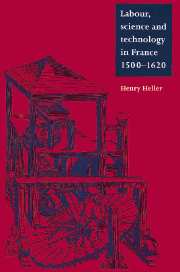Book contents
- Frontmatter
- Contents
- List of illustrations
- Preface
- List of abbreviations
- Introduction
- 1 The expansion of Parisian merchant capital
- 2 Labour in Paris in the sixteenth century
- 3 Civil war and economic experiments
- 4 Inventions and science in the reign of Charles IX
- 5 Expropriation, technology and wage labour
- 6 The Bourbon economic restoration
- 7 Braudel, Le Roy Ladurie and the inertia of history
- Bibliography
- Index
- CAMBRIDGE STUDIES IN EARLY MODERN HISTORY
5 - Expropriation, technology and wage labour
Published online by Cambridge University Press: 01 October 2009
- Frontmatter
- Contents
- List of illustrations
- Preface
- List of abbreviations
- Introduction
- 1 The expansion of Parisian merchant capital
- 2 Labour in Paris in the sixteenth century
- 3 Civil war and economic experiments
- 4 Inventions and science in the reign of Charles IX
- 5 Expropriation, technology and wage labour
- 6 The Bourbon economic restoration
- 7 Braudel, Le Roy Ladurie and the inertia of history
- Bibliography
- Index
- CAMBRIDGE STUDIES IN EARLY MODERN HISTORY
Summary
… In this place my best income is derived from manual labour. The work of a hundred men produces a profit which lasts a long time.
Montaigne, EssaisIn the 1560s, as we have seen, many initiatives were taken to try to reverse the onset of economic crisis. Indeed, the initial crisis of the early 1560s was followed by a partial recovery. It is only from 1575 to 1580 that one sees the full onslaught of economic depression. By then there is no question that the combination of the ravages of war, the burden of heavy taxation, the decline in population, and the lowering of profit margins was responsible for a serious economic regression. Le Roy Ladurie characterizes the period of the religious wars as a crisis of the second degree. By crisis of the second degree, he means one that was more serious than an ordinary cyclical downturn, but less severe than the total collapse of the fourteenth and fifteenth centuries. No doubt the difficulties of these concluding years of the sixteenth century were somewhat less serious than the catastrophic decline of the late middle ages, a crisis of the first magnitude. Still, there is little question that we are dealing with a severe economic setback.
WAR AND ECONOMIC DECLINE
One of the most serious aspects of this economic regression was the migration of skilled craftsmen, merchants and small-scale manufacturers out of the kingdom. The value of fixed capital in early modern industry was generally negligible.
- Type
- Chapter
- Information
- Labour, Science and Technology in France, 1500–1620 , pp. 119 - 156Publisher: Cambridge University PressPrint publication year: 1995



